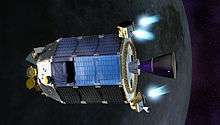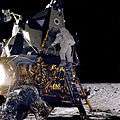Luna 24
 | |
| Mission type | Lunar sample return |
|---|---|
| COSPAR ID | 1976-081A |
| SATCAT № | 9272 |
| Mission duration | 13 days |
| Spacecraft properties | |
| Bus | Ye-8-5M |
| Manufacturer | GSMZ Lavochkin |
| Launch mass | 5,800 kg (12,800 lb) |
| Start of mission | |
| Launch date | 9 August 1976, 15:04:12 UTC |
| Rocket | Proton-K/D-1 |
| Launch site | Baikonur 81/23 |
| End of mission | |
| Landing date | 22 August 1976, 17:55 UTC |
| Landing site | 200 km (120 mi) SE of Surgut, Western Siberia |
| Orbital parameters | |
| Reference system | Selenocentric |
| Semi-major axis | 6,492.8 kilometres (4,034.4 mi) |
| Eccentricity | 0 |
| Periselene | 115 kilometres (71 mi) |
| Aposelene | 115 kilometres (71 mi) |
| Inclination | 120 degrees |
| Period | 119 minutes |
| Lunar orbiter | |
| Orbital insertion | 14 August 1976 |
| Orbits | ~48 |
| Lunar lander | |
| Landing date | 18 August 1976, 06:36 UTC |
| Return launch | 19 August 1976, 05:25 UTC |
| Landing site | 12°42′52″N 62°12′46″E / 12.7145°N 62.2129°E[1] |
| Sample mass | 170 grams (6.0 oz) |
| Instruments | |
|
Stereo photographic imaging system Improved drill/Remote arm for sample collection Radiation detector Radio-altimeter | |
Luna 24 was an unmanned space mission of the Soviet Union's Luna programme. The last of the Luna series of spacecraft, the mission of the Luna 24 probe was the third Soviet mission to retrieve lunar soil samples from the Earth's moon (the first two sample return missions were Luna 16 and Luna 20). The spacecraft orbital dry mass was 4,800 kg (10,600 lb).
The probe landed in Mare Crisium (Sea of Crises). The mission returned 170.1 grams (6.00 oz) of lunar samples to the Earth on 22 August 1976.
| Lunar mission |
Sample returned |
Year |
|---|---|---|
| Luna 16 | 101 g[2] | 1970 |
| Luna 20 | 30 g[3] | 1972 |
| Luna 24 | 170.1 g[4] | 1976 |
Luna 24 was the third attempt to recover a sample from the unexplored Mare Crisium, the location of a large lunar mascon (after Luna 23 and a launch failure in October 1975). After a trajectory correction on 11 August 1976, Luna 24 entered lunar orbit three days later. Initial orbital parameters were 115 by 115 kilometres (71 by 71 mi) at 120° inclination. After further changes to its orbit, Luna 24 set down safely on the lunar surface at 06:36 UT on 18 August 1976 at 12°45' north latitude and 62°12' east longitude, not far from where Luna 23 had landed.[5] Exact landing location (12.7145° N, 62.2097° E) was determined by the Lunar Reconnaissance Orbiter probe orbital cameras in 2012.[6]
Under command from ground control, the lander deployed its sample arm and pushed its drilling head about 2 metres into the nearby soil. The sample was safely stowed in the small return capsule, and after nearly a day on the Moon, Luna 24 lifted off successfully at 05:25 UT on 19 August 1976. After an uneventful return trip, Luna 24's capsule entered Earth's atmosphere and parachuted safely to land at 17:55 UT on 22 August 1976, about 200 kilometres (120 mi) southeast of Surgut in western Siberia. Study of the recovered 170.1 grams (6.00 oz) of soil indicated a laminated type structure, as if laid down in successive deposits. The Soviet Union swapped a gram of the mission sample for a lunar sample from NASA in December 1976.[5] Luna 24 was the last lunar spacecraft to be launched by the Soviet Union. It was also the last spacecraft to make a soft landing on the Moon until the landing of Chang'e 3 on December 14, 2013, 37 years later.
Detection of water in returned samples
In February 1978 soviet scientists M. Akhmanova, B. Dement'ev, and M. Markov of the Vernadsky Institute of Geochemistry and Analytic Chemistry published a paper claiming a detection of water fairly definitively.[7][8] Their study showed that the samples returned to Earth by the probe contained about 0.1% water by mass, as seen in infrared absorption spectroscopy (at about 3 µm wavelength), at a detection level about 10 times above the threshold.[9]
See also
References
- ↑ Samuel Lawrence (2013-09-24). "LROC Coordinates of Robotic Spacecraft - 2013 Update". lroc.sese.asu.edu. Archived from the original on 2015-05-09. Retrieved 2015-06-09.
- ↑ "NASA - NSSDC - Spacecraft - Details". nssdc.gsfc.nasa.gov. Retrieved 2015-11-08.
- ↑ "NASA - NSSDC - Spacecraft - Details". nssdc.gsfc.nasa.gov. Retrieved 2015-11-08.
- ↑ "NASA - NSSDC - Spacecraft - Details". nssdc.gsfc.nasa.gov. Retrieved 2015-11-08.
- 1 2 Solar System Exploration: Missions: By Nation: USSR: Luna 24 solarsystem.nasa.gov Retrieved: 2016-11-16. |deadurl =yes
- ↑ Plescia, Jeff (March 16, 2012). "Mare Crisium: Failure then Success". LROC News System.
- ↑ Akhmanova, M; Dement'ev, B; Markov, M (February 1978). "Water in the regolith of Mare Crisium (Luna-24)?". Geokhimiya (in Russian) (285).
- ↑ Akhmanova, M; Dement'ev, B; Markov, M (1978). "Possible Water in Luna 24 Regolith from the Sea of Crises". Geochemistry International. 15 (166).
- ↑ Crotts, Arlin (2012). "Water on The Moon, I. Historical Overview". arXiv:1205.5597v1
 [astro-ph.EP].
[astro-ph.EP].
External links
- Zarya - Luna 24 chronology
- NASA NSSDC Master Catalog
- "Soviet Moon Lander Discovered Water on The Moon in 1976". The Physics arXiv Blog. Technology Review. May 30, 2012.
- Mare Crisium: Failure then Success, article showing LROC images of Luna 23 and 24 on the lunar surface

